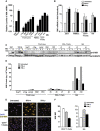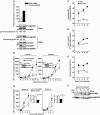90K, an interferon-stimulated gene product, reduces the infectivity of HIV-1
- PMID: 24156545
- PMCID: PMC3827937
- DOI: 10.1186/1742-4690-10-111
90K, an interferon-stimulated gene product, reduces the infectivity of HIV-1
Abstract
Background: In response to viral infections, interferons induce the transcription of several hundred genes in mammalian cells. Specific antiviral functions, however, have only been attributed to a few of them. 90K/LGALS3BP has been reported to be an interferon-stimulated gene that is upregulated in individuals with cancer or HIV-1 infection.
Results: Here, we show that 90K expression dose-dependently decreased the particle infectivity of HIV-1 progeny. The lower infectivity of released particles correlated with reduced virion incorporation of mature envelope glycoproteins gp120 and gp41. Further, proteolytic processing of the gp160 precursor and surface expression of gp120 in the producer cell were impaired in the presence of 90K expression. In contrast, expression of Gag, Nef and Vpu, and virus release were not grossly affected by 90K expression. 90K-imposed restriction occurred in the absence of direct interaction of 90K with HIV-1 Env or entrapment of Env in the ER. The cell-associated, but not the secreted species of 90K, mediated the antiviral effect. A truncated version of human 90K, solely consisting of the two intermediate domains, displayed a similar antiviral activity as the full-length wildtype 90K, indicating that the N-terminal SRCR-like domain and the C-terminal domain are dispensable for 90K's antiviral activity. The murine homolog of 90K, CypCAP (Cyclophilin C-associated protein), neither modulated particle infectivity of HIV-1 nor lowered the virion incorporation of mature gp120, suggesting a species-specific mode of action. 90K was expressed at basal levels in TZM-bl cells and in primary macrophages, and at low levels in CD4⁺ T-cells and PBMCs. 90K's susceptibility to IFN-mediated stimulation of expression was cell type-specific. siRNA-mediated knockdown of 90K in TZM-bl cells and primary macrophages enhanced the incorporation of Env glycoproteins into progeny virions, boosted the particle infectivity of released HIV-1, and accelerated HIV-1 spread. Conversely, treatment of HIV-1 infected macrophages with IFN-α induced 90K expression and lowered the particle infectivity of HIV-1.
Conclusions: Thus, 90K constitutes a novel antiviral factor that reduces the particle infectivity of HIV-1, involving interference with the maturation and incorporation of HIV-1 Env molecules into virions.
Figures








Similar articles
-
The Antiviral Activity of the Cellular Glycoprotein LGALS3BP/90K Is Species Specific.J Virol. 2018 Jun 29;92(14):e00226-18. doi: 10.1128/JVI.00226-18. Print 2018 Jul 15. J Virol. 2018. PMID: 29743357 Free PMC article.
-
Glycosyl-Phosphatidylinositol-Anchored Anti-HIV Env Single-Chain Variable Fragments Interfere with HIV-1 Env Processing and Viral Infectivity.J Virol. 2018 Mar 14;92(7):e02080-17. doi: 10.1128/JVI.02080-17. Print 2018 Apr 1. J Virol. 2018. PMID: 29321330 Free PMC article.
-
The Polar Region of the HIV-1 Envelope Protein Determines Viral Fusion and Infectivity by Stabilizing the gp120-gp41 Association.J Virol. 2019 Mar 21;93(7):e02128-18. doi: 10.1128/JVI.02128-18. Print 2019 Apr 1. J Virol. 2019. PMID: 30651369 Free PMC article.
-
Cellular Antiviral Factors that Target Particle Infectivity of HIV-1.Curr HIV Res. 2016;14(3):211-6. doi: 10.2174/1570162x14666151216145521. Curr HIV Res. 2016. PMID: 26674651 Free PMC article. Review.
-
Viral and Host Factors Regulating HIV-1 Envelope Protein Trafficking and Particle Incorporation.Viruses. 2022 Aug 5;14(8):1729. doi: 10.3390/v14081729. Viruses. 2022. PMID: 36016351 Free PMC article. Review.
Cited by
-
Genetic Architecture of Immune Cell DNA Methylation in the Rhesus Macaque.Mol Ecol. 2025 Aug;34(15):e17576. doi: 10.1111/mec.17576. Epub 2024 Nov 24. Mol Ecol. 2025. PMID: 39582237 Free PMC article.
-
Vpr Enhances HIV-1 Env Processing and Virion Infectivity in Macrophages by Modulating TET2-Dependent IFITM3 Expression.mBio. 2019 Aug 20;10(4):e01344-19. doi: 10.1128/mBio.01344-19. mBio. 2019. PMID: 31431548 Free PMC article.
-
HIV-1 Envelope Glycoprotein at the Interface of Host Restriction and Virus Evasion.Viruses. 2019 Mar 30;11(4):311. doi: 10.3390/v11040311. Viruses. 2019. PMID: 30935048 Free PMC article. Review.
-
ASCT2 inhibits HIV-1 infectivity by promoting the incorporation of a gp160/ASCT2 complex into virions.mBio. 2025 Aug 13;16(8):e0146525. doi: 10.1128/mbio.01465-25. Epub 2025 Jul 21. mBio. 2025. PMID: 40689623 Free PMC article.
-
Several cell-intrinsic effectors drive type I interferon-mediated restriction of HIV-1 in primary CD4+ T cells.Cell Rep. 2023 Jun 27;42(6):112556. doi: 10.1016/j.celrep.2023.112556. Epub 2023 May 23. Cell Rep. 2023. PMID: 37227817 Free PMC article.
References
-
- Van Damme N, Goff D, Katsura C, Jorgenson RL, Mitchell R, Johnson MC, Stephens EB, Guatelli J. The interferon-induced protein BST-2 restricts HIV-1 release and is downregulated from the cell surface by the viral Vpu protein. Cell Host Microbe. 2008;3(4):245–252. doi: 10.1016/j.chom.2008.03.001. - DOI - PMC - PubMed
Publication types
MeSH terms
Substances
LinkOut - more resources
Full Text Sources
Other Literature Sources
Research Materials
Miscellaneous

